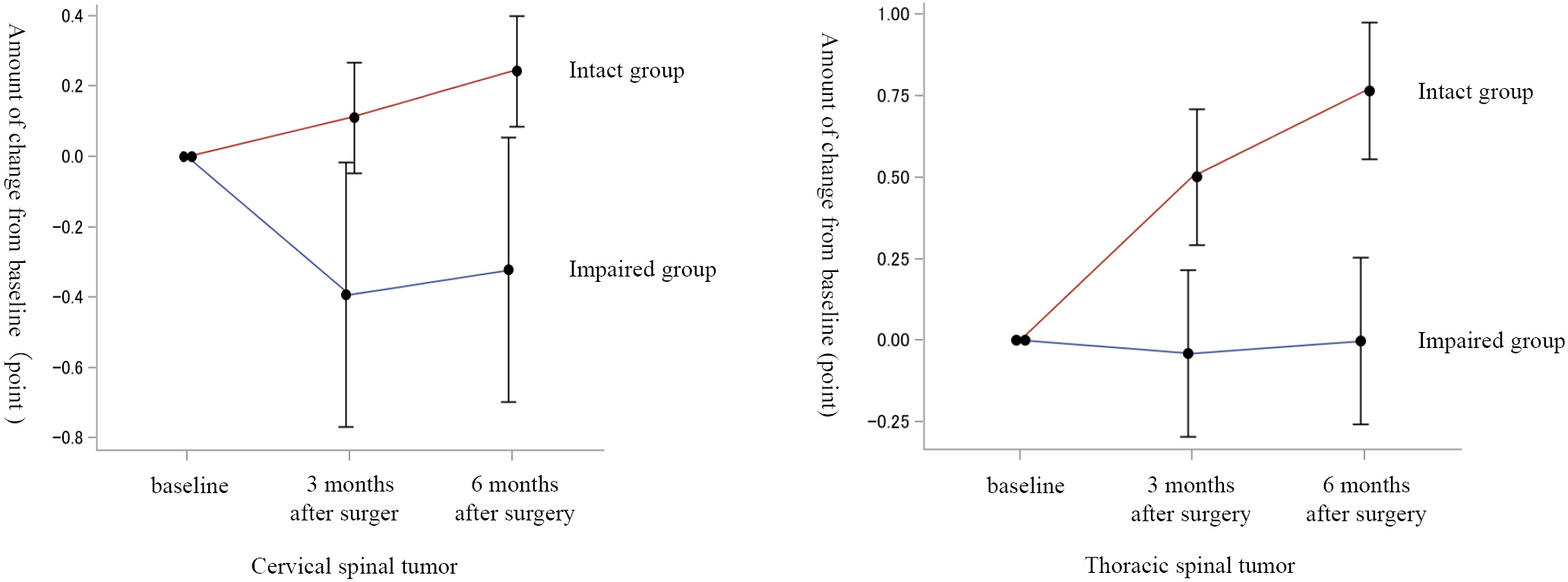- 著者
- Ryo Fukata Takeo Furuya Yuki Shiko Yohei Kawasaki Mayuko Kuwata Keita Takase Ryosuke Tadaki Tomoyo Akasaka Geundong Kim Yahiko Takeuchi Mitsuo Morita Atsushi Murata Seiji Ohtori
- 出版者
- The Japanese Society for Spine Surgery and Related Research
- 雑誌
- Spine Surgery and Related Research (ISSN:2432261X)
- 巻号頁・発行日
- vol.7, no.5, pp.414-420, 2023-09-27 (Released:2023-09-27)
- 参考文献数
- 31
Introduction: We investigated the effect of preoperative joint position sense in the big toe on the postoperative recovery of gait function after spinal tumor surgery.Methods: Seventy-three patients with spinal tumors who underwent surgery at our hospital between 2014 and 2019 and could be followed for at least 6 months after surgery were included. The patients were divided into the cervical spinal (41 cases) and thoracic spinal (32 cases) groups according to the localization of the tumor. These groups were further classified into an Impaired group (cervical spinal, 34 cases; thoracic spinal, 19 cases) and an Intact group (cervical spinal, 7 cases; thoracic spinal, 13 cases) according to the presence or absence of preoperative joint position sense in the big toe. The amount of change in ambulatory function from the preoperative period to 3 and 6 months postoperatively was compared between the Impaired and Intact groups within each tumor localization category.Results: Impaired preoperative joint position sense in the big toe in patients undergoing thoracic spinal tumor surgery delayed the recovery of gait function in the early postoperative period.Conclusions: In patients with thoracic spinal tumor surgery, the absence of preoperative joint position sense in the big toe delayed the recovery of postoperative gait function.
- 著者
- KIICHIRO HIGASHI MITSUO MORITA JUNICHI TAJIRI TATSUO SATO KOSHIRO OKAZAKI SUMIO ARAI
- 出版者
- The Japan Endocrine Society
- 雑誌
- Endocrinologia Japonica (ISSN:00137219)
- 巻号頁・発行日
- vol.32, no.3, pp.421-426, 1985 (Released:2011-01-25)
- 参考文献数
- 13
- 被引用文献数
- 1
In order to obtain a good separation line between patients with primary hyperparathyroidism (1°HPT) and those with non-parathyroidal hypercalcemia (NPHC), serum chloride (Cl) and phosphate (P) concentrations were analyzed. Ninety-nine per cent of the patients with 1°HPT had a Cl/P ratio greater than or equal to 33, but 29% of patients with NPHC were also included in this range. When the (Cl-90)/P ratio was used to separate into two groups, 98% of the patients with 1°HPT had a ratio greater than or equal to 5.0, and 94% of the patients with NPHC had a ratio less than 5.0. From these results, while high sensitivity was achieved both with the Cl/P and (Cl-90)/P ratios, the (Cl-90)/P ratio provided higher specificity. Therefore we concluded that the (Cl-90)/P ratio was excellent in distinguishing 1°HPT from other types of hypercalcemia.
